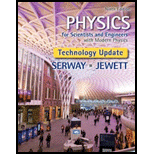
Concept explainers
(a)
The equivalent capacitance between
(a)
Answer to Problem 22P
The equivalent capacitance between
Explanation of Solution
Write the expression for equivalent capacitance for capacitor
Here,
Write the expression for equivalent capacitance for capacitor
Here,
Write the expression for equivalent capacitance for capacitor
Here,
In the
Here,
Write the expression for the equivalent capacitance for
Here,
Conclusion:
Substitute
Substitute
Substitute
Substitute
Substitute
Therefore, the equivalent capacitance between
(b)
The charge stored in
(b)
Answer to Problem 22P
The charge stored in
Explanation of Solution
Write the expression for the total charge stored in the circuit.
Here,
Write the expression to calculate the voltage in the lower part of the circuit.
Here,
Write the expression to calculate the total voltage.
Here,
Write the expression to calculate the charge stored in the capacitor
Here, the charge stored in capacitor
Conclusion:
Substitute
Substitute
Substitute
Substitute
Therefore, the charge stored in
Want to see more full solutions like this?
Chapter 26 Solutions
Physics for Scientists and Engineers with Modern Physics, Technology Update
- Figure P27.75 shows four capacitors with CA = 4.00 F, CB = 8.00 F. CC = 6.00 F. and CD = 5.00 F connected across points a and b, which have potential difference Vab = 12.0 V. a. What is the equivalent capacitance of the four capacitors? b. What is the charge on each of the four capacitors?arrow_forwardGiven the arrangement of capacitors in Figure P27.23, find an expression for the equivalent capacitance between points a and b. Figure P27.23 Problems 23 and 24.arrow_forward(a) Find the equivalent capacitance between points a and b for the group of capacitors connected as shown in Figure P20.44. Take C1 = 5.00 F, C2 = 10.0 F, and C3 = 2.00 F. (b) What charge is stored on C3 if the potential difference between points a and b is 60.0 V? Figure P20.44arrow_forward
- What If? The two capacitors of Problem 13 (C1 = 5.00 F and C2 = 12.0 F) are now connected in series and to a 9.00-Y battery. Find (a) the equivalent capacitance of the combination. (b) the potential difference across each capacitor, and (c) the charge on each capacitor.arrow_forwardFind the equivalent capacitance between points a and b in the combination of capacitors shown in Figure P20.51. Figure P20.51arrow_forwardFind (a) the equivalent capacitance of the capacitors in Figure P26.26, (b) the charge on each capacitor, and (c) the potential difference across each capacitor.arrow_forward
- (a) Find the equivalent capacitance between points a and b for the group of capacitors connected as shown in Figure P25.12 (page 686). Take C1 = 5.00 F, C2 = 10.0 F, and C3 = 2.00 F. (b) What charge is stored on C3 if the potential difference between points a and b is 60.0 V? Figure P25.12arrow_forward(a) Find the equivalent capacitance between points a and b for the group of capacitors connected as shown in Figure P16.46 if C1 = 5.00 F, C2 = 10.00 F, and C3 = 2.00 F. (b) If the potential between points a and b is 60.0 V, what charge is stored on C5? Figure P16.46arrow_forwardFour capacitors are connected as shown in Figure P16.48. (a) Find the equivalent capacitance between points a and b. (b) Calculate the charge on each capacitor, taking Vab = 15.0 V. Figure P16.48arrow_forward
- Four capacitors are connected as shown in Figure P25.11. (a) Find the equivalent capacitance between points a and b. (b) Calculate the charge on each capacitor, taking Vab = 15.0 V. Figure P25.11arrow_forwardFind the charge on each of the capacitors in Figure P16.43. Figure P16.43arrow_forwardA parallel-plate capacitor has square plates of side s = 2.50 cm and plate separation d = 2.50 mm. The capacitor is charged by a battery to a charge Q = 4.00 C, after which the battery is disconnected. A porcelain dielectric ( = 6.5) is then inserted a distance y = 1.00 cm into the capacitor (Fig. P27.88). Hint: Consider the system as two capacitors connected in parallel. a. What is the effective capacitance of this capacitor? b. How much energy is stored in the capacitor? c. What are the magnitude and direction of the force exerted on the dielectric by the plates of the capacitor? Figure P27.88arrow_forward
 Principles of Physics: A Calculus-Based TextPhysicsISBN:9781133104261Author:Raymond A. Serway, John W. JewettPublisher:Cengage Learning
Principles of Physics: A Calculus-Based TextPhysicsISBN:9781133104261Author:Raymond A. Serway, John W. JewettPublisher:Cengage Learning Physics for Scientists and Engineers with Modern ...PhysicsISBN:9781337553292Author:Raymond A. Serway, John W. JewettPublisher:Cengage Learning
Physics for Scientists and Engineers with Modern ...PhysicsISBN:9781337553292Author:Raymond A. Serway, John W. JewettPublisher:Cengage Learning Physics for Scientists and EngineersPhysicsISBN:9781337553278Author:Raymond A. Serway, John W. JewettPublisher:Cengage Learning
Physics for Scientists and EngineersPhysicsISBN:9781337553278Author:Raymond A. Serway, John W. JewettPublisher:Cengage Learning College PhysicsPhysicsISBN:9781305952300Author:Raymond A. Serway, Chris VuillePublisher:Cengage Learning
College PhysicsPhysicsISBN:9781305952300Author:Raymond A. Serway, Chris VuillePublisher:Cengage Learning College PhysicsPhysicsISBN:9781285737027Author:Raymond A. Serway, Chris VuillePublisher:Cengage Learning
College PhysicsPhysicsISBN:9781285737027Author:Raymond A. Serway, Chris VuillePublisher:Cengage Learning Physics for Scientists and Engineers, Technology ...PhysicsISBN:9781305116399Author:Raymond A. Serway, John W. JewettPublisher:Cengage Learning
Physics for Scientists and Engineers, Technology ...PhysicsISBN:9781305116399Author:Raymond A. Serway, John W. JewettPublisher:Cengage Learning





